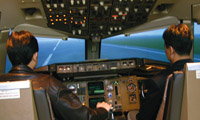Special Report: Training in the Asia-Pacific
Asia to the fore in CAE boom year
July 1st 2012
It has been a boom year for Canadian simulator and training major, CAE, as it significantly boosted its presence in the Asia-Pacific through acquisition of a leading flight training group and new sales of its simulator products, including wider penetration of the Chinese market. Read More »
Last month, CAE announced simulator deals worth $63.5million, including a contract to provide the world’s first full-flight simulator (FFS) for a new medium-sized commercial transport aircraft being designed and built by the Aviation Industry Corporation of China (AVIC).
 |
| Zhuhai Flight Training Centre is the largest independent commercial aviation training centre in China |
It also sold an A330 FFS to Singapore Airlines and an A320 FFS to Zhuhai Flight Training Centre (ZFTC), a joint venture of China Southern Airlines and CAE.
These sales came just a month after confirmation the Canadian company had acquired one of the world’s leading flight training groups, Oxford Aviation Academy, for $306.5 million, a move that has strengthened its global training footprint, particularly in the Asian region.
That purchase added seven new civil aviation training centres to CAE’s network, making a total of 42 worldwide. Oxford, which will now be rebranded as CAE Oxford Aviation Academy, has seven type-rating training facilities in Denmark, Norway, Sweden, the UK and Hong Kong, equipped with 40 full-flight simulators and 27 cabin crew trainers. CAE has 211 full-flight simulators in operation globally.
Oxford also has four ab-initio flight academies - in Australia, Hong Kong, the UK and the U.S. - equipped with 88 aircraft. OAA’s ab initio flight academies have trained 26,000 pilots in the past 50 years. The addition of the Oxford flight schools brings the number of CAE-operated flight schools to 12 with a capacity to train 1,500 cadets annually.
Included in the deal, CAE also acquired Parc Aviation, a global leader in providing pilots and maintenance personnel on lease to the aviation industry. Headquartered in Dublin, with offices in China and Japan, it provides 1,200 aviation personnel on assignments to more than 50 airlines and leasing companies in 40 countries, many of them in Asia.
CAE employs close to 8,000 people at more than 100 sites and training locations in some 30 countries.
“Civil aerospace market fundamentals are strong and we are increasing our position at an opportune time,” said Marc Parent, president and CEO of CAE.
Jeff Roberts, CAE’s group president, civil simulation products, training and services, said developing the first FFS for a new aircraft such as AVIC’s medium-sized transport plane, presented unique challenges.
The CAE 7000 Series FFS will incorporate the new third-generation CAE Tropos (TM)-6000 visual system and will be ready for training at AVIC’s facility in Yan Liang, China by the end of 2014, initially qualified to Interim Level C standards. The simulator will be qualified to Level D standards once aircraft flight data is available.
In addition, AVIC will make use of CAE’s Augmented Engineering Environment (AEE) toolkit in the development of the aircraft. It enables original equipment manufacturers (OEMs) to evaluate, test, and validate a range of aircraft models and systems during the development phase.
Delivery of the Zhuhai Flight Training Centre A320 FFS will be in 2013. ZFTC is the largest independent commercial aviation training centre in China, operating 16 FFSs.